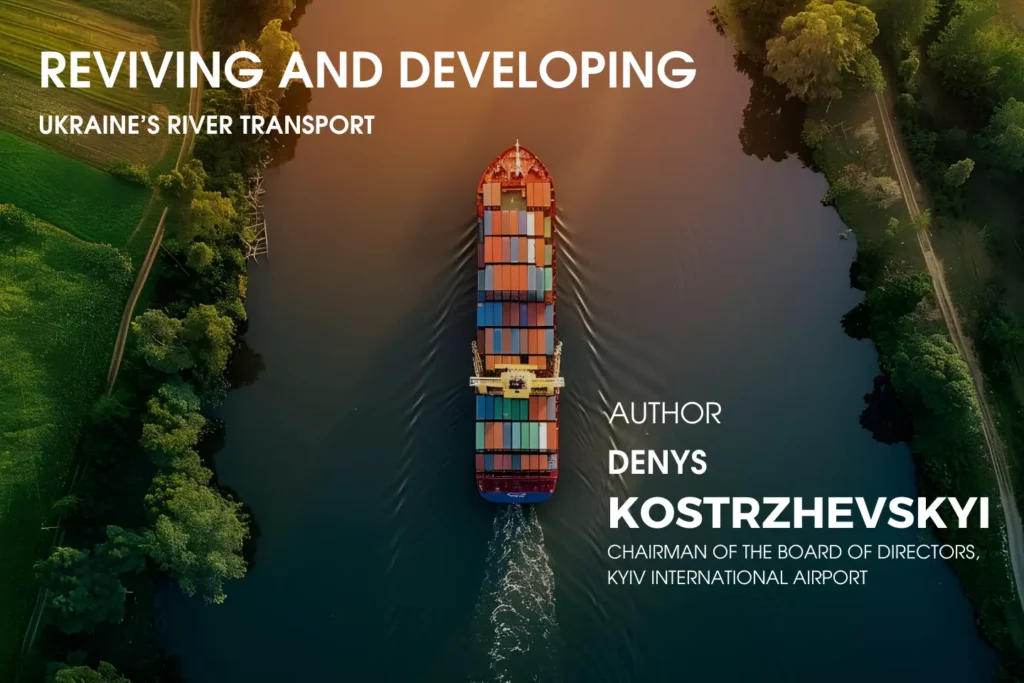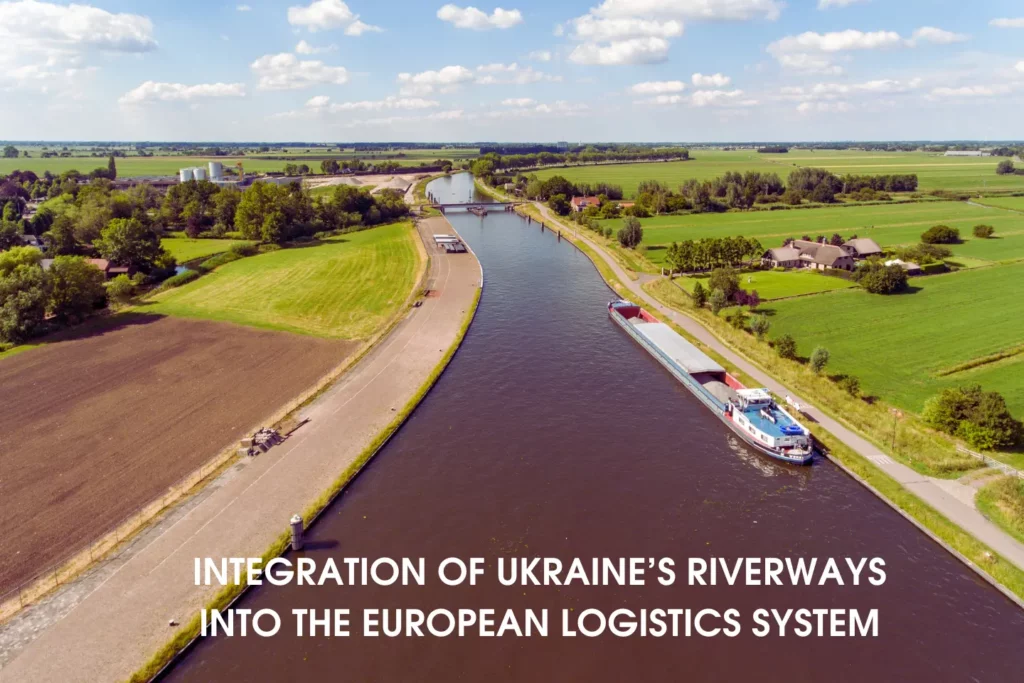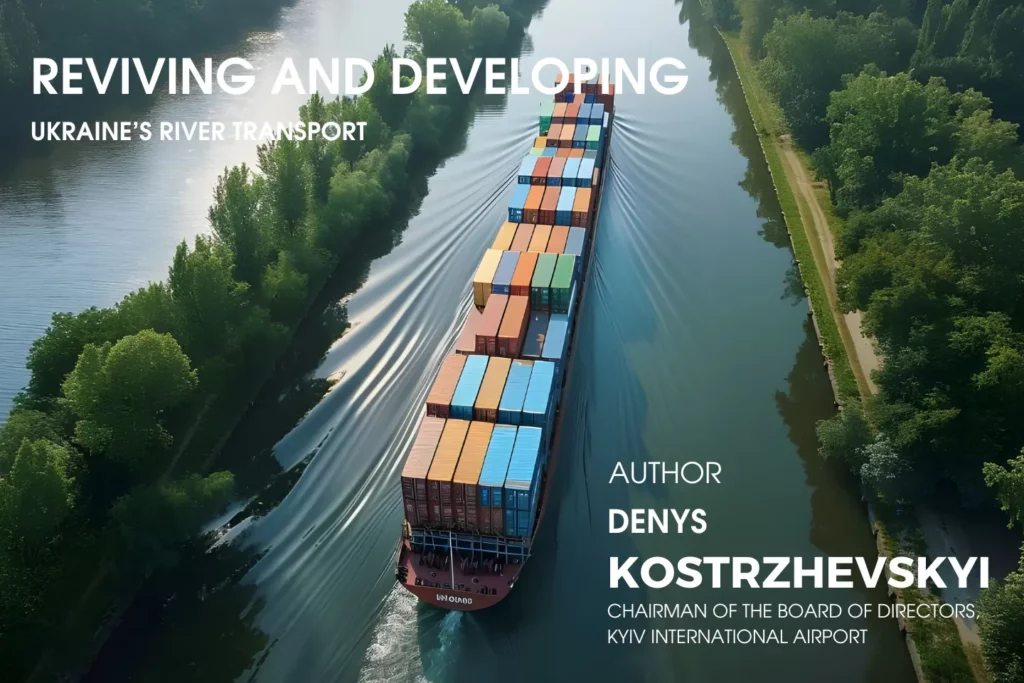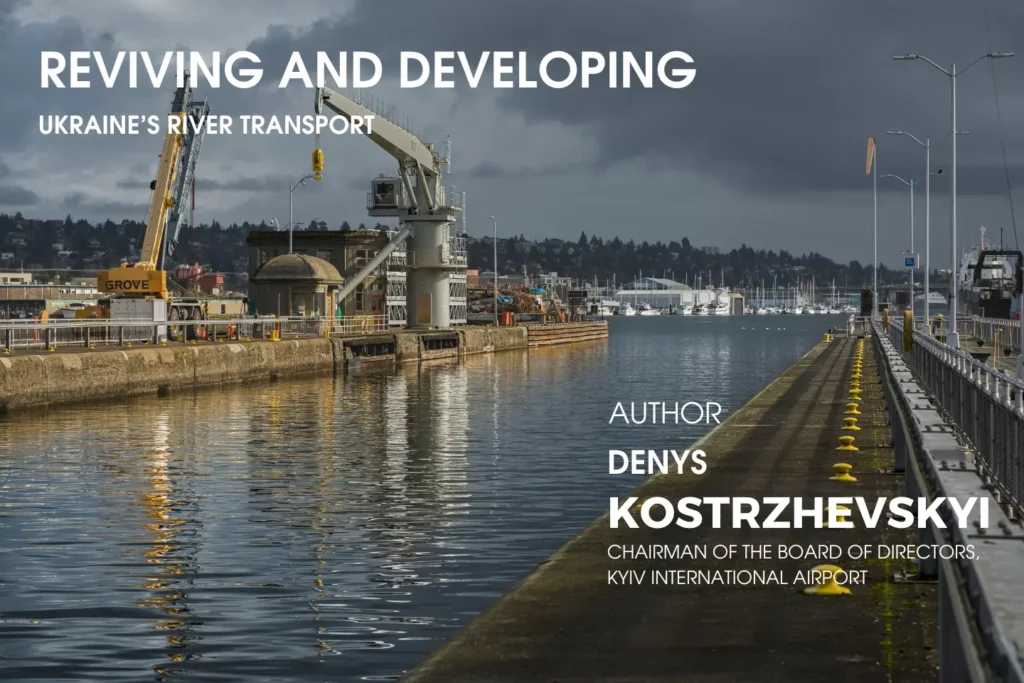Denys Kostrzhevskyi – Reviving and Developing Ukraine’s River Transport
Author: Denys Kostrzhevskyi, Chairman of the Board of Directors, Kyiv International Airport
Ukraine’s river transport system boasts a rich history, having played a crucial role in the nation’s economic and logistical framework. As the country faces a full-scale war, the significance of river routes has never been greater. With sea ports blocked and transportation routes disrupted, the need for alternative cargo transport methods has become urgent. River transport could emerge as a key element of the national logistics infrastructure, helping to stabilize the economy and sustain both domestic and international shipments in these difficult times.
Spanning over 4,400 kilometers of navigable waterways—including the Dnipro, Danube, Southern Buh, and Dniester rivers—Ukraine’s river transport holds the potential for a substantial increase in cargo turnover. However, this mode of transport remains largely underutilized and undervalued.
Unlike European countries, where river transport accounts for up to 16.3% of total cargo turnover, in Ukraine, this figure does not exceed 0.5%. The primary reasons are outdated infrastructure, insufficient investment, and a general underappreciation of this form of transport.
Despite these challenges, river transport offers significant advantages: it is more environmentally friendly and far more economically efficient compared to rail, road, and air transport. While river navigation is largely dependent on weather conditions—halting in the winter months—this limitation has diminished in recent years due to global warming. Today, as the country confronts wartime challenges, the restoration and development of river infrastructure have become strategically vital tasks for both the government and businesses.
Let us examine the current state of river transport in Ukraine, identify the key obstacles hindering its growth, and propose strategic steps for reviving the sector amid war and laying the foundation for future economic development.

Infrastructure Review of Ukraine’s River Transport: An Economic Analysis
The first step in the revival of Ukraine’s river transport is a comprehensive review of the existing infrastructure, including waterways, ports, locks, and the fleet. This stage is crucial in determining investment requirements and prioritizing modernization efforts.
Key waterways like the Dnipro and Danube have immense potential, but their condition has deteriorated due to natural silting and a lack of systematic dredging. For example, to maintain a minimum channel depth of 3.65 meters on the Dnipro, increased capital investment is needed, which would, in turn, boost cargo flow by 20-30%.
River ports, which play a key role in transshipment and cargo storage, also require significant investment. Most ports are equipped with outdated machinery that no longer meets modern standards.
Equally important is the modernization of the locks on the Dnipro, which are essential for maintaining navigation throughout the river system. According to Ukraine’s Ministry of Infrastructure, approximately 1 billion hryvnias are needed to renovate six major locks. Without these upgrades, Ukraine risks losing a substantial portion of its cargo traffic, as the existing locks will struggle to handle the rising volume of shipments.
The state of Ukraine’s river fleet also requires urgent attention. The majority of the vessels in operation are over 50 years old, which not only decreases transport efficiency but also raises maintenance costs. Fleet renewal requires billions of hryvnias, but the return on investment would be swift. New vessels could lower transportation costs by 15-20% and enhance the competitiveness of river transport on both the domestic and international markets.
Overall, the costs of modernizing the infrastructure may exceed 50 billion hryvnias, but these investments are essential for reviving river transport and ensuring its competitiveness in today’s challenging economic climate.
Creating a National River Logistics Network
The second stage of reviving Ukraine’s river transport is the creation of a national river logistics network, which will serve as the foundation for efficient cargo transportation and integration with other modes of transport.
A key aspect of this stage is the integration with rail and road transport. Logistics hubs located at the intersections of river, rail, and road networks will significantly reduce shipping costs and speed up delivery times. This will be possible through the establishment of an efficient system for transshipping goods between different modes of transport.
Additionally, attracting private capital through public-private partnerships will be essential. Private investors can play a major role in developing river infrastructure, including the construction and modernization of port facilities, the acquisition of modern transshipment equipment, and the maintenance of navigational infrastructure. This approach would ensure stable funding and improve the management efficiency of infrastructure facilities.
Developing a national river logistics development program is another crucial task. Such a program should address both domestic needs and export expansion opportunities. It should integrate Ukraine’s river routes into European and international logistics networks, allowing the country to make better use of its river resources.
Ukraine should also draw from the successful experiences of European countries such as Austria, Germany, and the Netherlands, where river transport plays a vital role in the economy.
Austria: The Danube Model
Austria effectively utilizes the Danube as its primary river artery. In 2020, river transport handled over 12 million tons of cargo, accounting for about 10% of the country’s total cargo turnover. Through integration with rail and road transport, Austria has significantly reduced logistics costs. Investments in port infrastructure have increased cargo volume by 15% over the past five years, enhancing Austria’s economic efficiency and strengthening its position in international transport corridors.
One of the key factors in the success of this model is the strategic location of ports along the Danube, which serve not only domestic transportation but also transit operations with neighboring EU countries. This enables Austria’s river transport sector to effectively compete with other modes of transport, offering a stable and environmentally friendly way to move goods.
Germany: Integration, Economic Efficiency, and Investment
Germany, leveraging the Rhine River, has created one of the most powerful river transport corridors in Europe. In 2022, river transport moved over 220 million tons of cargo, accounting for approximately 30% of the country’s internal freight traffic. Thanks to high levels of port automation, modern logistics management technologies, and integration with rail and road transport, Germany has reduced transportation costs by 25% compared to other transport modes, ensuring faster and more reliable deliveries.
A key factor in this success is the smart integration of river transport into the country’s overall transport system. As a result, the Rhine serves not only as a major domestic waterway but also as an international transport corridor connecting key economic centers across Europe. A particularly important role in this process has been played by investments in the Port of Duisburg, totaling over 500 million euros. These funds were directed toward the automation and expansion of the port’s infrastructure, increasing its capacity by 20% and significantly boosting the economic efficiency of Germany’s entire logistics system.
In Germany, the river transport and logistics infrastructure operate based on cooperation between the state and the private sector. The Port of Duisburg, for example, is partly state-owned but also attracts significant private investment. This model ensures high management efficiency and the ability to attract large investments for infrastructure development. Private companies actively invest in port modernization, process automation, and the development of logistics chains, while the state provides regulatory support and investment incentives.
The Netherlands: Innovation
The Netherlands, with one of the most extensive river networks in Europe, is an example of successful innovation and sustainable development in river transport. The government, together with private companies, has invested over 1 billion euros in port automation and modernization. This has increased transshipment efficiency by 20% and reduced CO2 emissions by 15%. In 2021, river transport moved over 300 million tons of cargo, accounting for 42% of the country’s domestic freight turnover, highlighting the crucial role the river network plays in ensuring stable and environmentally friendly logistics.

Integration of Ukraine’s Riverways into the European Logistics System
Ukraine, with its shared navigable rivers with the EU—particularly the Danube—has the potential to integrate its river transport into the European logistics network. Investment in Ukrainian ports could increase cargo turnover by 25-30% and create new jobs. Experts estimate that integrating river transport with rail and road systems could reduce logistics costs by 15-20%, greatly enhancing Ukraine’s competitiveness on the international market.
Leveraging European expertise will enable Ukraine to establish an efficient national river logistics network, fostering economic growth, lowering logistics costs, and boosting the country’s competitiveness in global markets. Integrating Ukraine’s riverways into the European logistics system will be a vital step in this process.

Renewal and Modernization of the River Fleet
The third stage of reviving Ukraine’s river transport involves renewing and modernizing the river fleet, which will be crucial for improving the efficiency and sustainability of shipping.
First and foremost, the existing fleet needs modernization. This includes installing modern engines that reduce fuel consumption and upgrading navigation systems to improve safety and accuracy. Renewing vessels will also lower maintenance costs and extend their operational life. Experts estimate that modernizing a single vessel could reduce operational costs by 20-30% while increasing cargo capacity.
The second important task is the construction of new ships. Investments in new, modern vessels that meet EU environmental standards will enable Ukraine to compete on the international market. Particularly important are “river-sea” vessels, which can operate on both inland waterways and the Black Sea, enhancing Ukraine’s export potential. The construction of such vessels may cost millions of euros, but these investments will quickly pay off due to increased cargo volumes. Ukraine has significant potential in shipbuilding, and revitalizing shipbuilding and repair facilities will provide a major boost to related industries, such as metallurgy, oil refining, chemicals, and instrumentation. This will create tens of thousands of new jobs. With steady domestic demand for new vessels, Ukrainian shipyards will be able to ramp up production and expand into new international markets.
Another important aspect is the implementation of digital technologies. Modern IT solutions, such as fleet monitoring and management systems, will optimize routes, reduce fuel consumption, and improve operational efficiency. For example, the introduction of an automatic monitoring system could cut fuel costs by 10-15%, which is especially important given the rising energy prices.
Renewing and modernizing the river fleet are key to ensuring the sustainable development of river transport in Ukraine. This third stage will enhance the competitiveness of river transport, reduce transportation costs, and contribute to environmental goals by lowering emissions and minimizing environmental impact.

Conclusion
Ukraine has considerable untapped potential in river transport, with over 4,400 kilometers of navigable rivers. However, unlike European countries, where river transport accounts for up to 16.3% of cargo traffic, in Ukraine, this figure does not exceed 0.5%. The main problems are an outdated fleet (81.9% of vessels are technically obsolete) and insufficient infrastructure investment.
The development of river transport in Ukraine requires large-scale investments, fleet renewal, infrastructure modernization, and the adoption of new legislative initiatives. Integrating Ukraine’s riverways with the European logistics system, particularly through the development of shipping on the Dnipro and Danube rivers, could be a key factor in boosting Ukraine’s economic competitiveness and creating new jobs.
Implementing these measures will not only improve the economic situation but will also strengthen Ukraine’s position as a major transport hub within international logistics corridors, marking a significant step toward economic growth and Ukraine’s integration into the European space.
Author: Denys Kostrzhevskyi, Chairman of the Board of Directors, Kyiv International Airport
